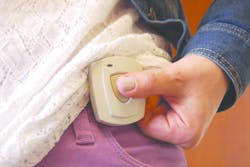Retail: In Case of Emergency, Press Button
Most images of “holdup buttons” come from the movies — where a bank manager or employee under siege slyly reaches under a counter to push a red button. Then, within seconds, the sounds of sirens fill the air and the real action begins.
Today, wireless holdup buttons and compact “duress pendants” are being used to add much-needed people protection to the security mix. Banks still are leaders in panic button use, but a host of new applications are making their way into a variety of industries, including retail. The “holdup button” is finding more uses in over-the-counter cash transaction-based businesses, such as convenience, gas, bill payment and retail outlets. The adoption of holdup buttons is supported by a 2013 study by the National Retail Foundation (NRF) which found that retailers lose about $30 billion each year to organized retail crime.
This challenge of reducing shrinkage and protecting people — and thwarting increasing workplace violence, helps mitigate risk to the people who are working or shopping at a retail location. That is why it is imperative that these businesses provide a level of protection not only for merchandise, but also for employees, and anyone who may be shopping or visiting an establishment. As a result, an increasing number of retail operators are installing holdup buttons and mobile duress pendants as part of their overall security solution. Generally, these buttons will be located under a counter — which is how they are typically used in banking, education and sometimes healthcare — enabling an employee to inconspicuously push them if there is a security threat. The button then sends an alert that notifies the appropriate authorities that help is needed. Many holdup buttons have been designed with features that prevent false alarms — such as the requirement to push two buttons — while remaining discreet enough for employees to call for help without escalating a situation.
Building on the images of TV and movie “silent alarm” scenarios, today’s holdup buttons are a simple way for integrators and dealers to grow RMR, while offering customers a security option that directly benefits and protects the people that serve customers and run the business. The evolution of duress buttons now includes wireless options that can provide reliable coverage in a constantly changing environment, and can be easily integrated into existing systems.
Retail Security Challenges
Retail facilities possess several elements that make them vulnerable to theft, robbery and possibly even more violent crimes. Typically, in retail environments no one is screening people at the door. And, certain types of retail establishments (convenience stores, quick-serve restaurants, pawn shops), are open all the time, causing even greater concern for safety. Also, unlike many other environments, cash is changing hands — a potential magnet for crime. Merchandise is available on the floor, and it is an open environment where people move about freely.
With a holdup button or a mobile pendant of any kind, retailers can empower employees by providing the ability to summon help discreetly and avoid making a bad situation worse. “As an integrator who works a lot with retail operators, the number-one security issue among my customers is employee safety,” says Trey Walling, senior client executive at SageNet, a technology solutions provider specializing in mission-critical business solutions and managed services, in Tulsa, Okla. “For a security dealer or integrator, there is great value in bringing a holdup button into the sales discussion, because ultimately, the protection of both people and merchandise in retail stores are a top priority.”
In retail, a security solution needs to be scalable enough to accommodate a variety of retail settings and flexible enough to perform in a rapidly changing and mobile environment. While holdup buttons historically have been fixed on a wall or under a counter, they have evolved to meet mobile demands, which are a requirement in today’s retail settings, as employees interact more freely on the floor and throughout the merchandise displays.
With the incorporation of wireless technology, there is now the option for an employee to carry a device or pendant as they move throughout the store. For a dealer or integrator, this introduces another security option into the conversation with the customer, and provides a viable option for retailers that need the flexibility to accommodate a highly mobile staff. Wireless also brings value to retail through the flexibility to adapt to ever-changing environments. For example, a store may reorganize its merchandise for seasonal or special promotions. With a properly suited wireless network, retailers can freely move goods to grab the shopper’s attention, and help clear inventory or promote sales items without the concern of additional cost or compromised security.
Installing the System
Holdup buttons and mobile duress pendants are always part of a larger security system that combines a number of security devices. In retail, as stated, it usually includes a wireless sensor network that is distributed throughout the store, and a companion receiver to hear and package the alerts and alarms for downstream processing and response. Sometimes, depending on a facility’s size, a wireless repeater is used to extend coverage beyond obvious areas, such as cash registers, into other more remote locations, like dressing rooms, stock rooms, parking lots, trash receptacle areas, loading docks and back-office meeting rooms.
The network serves as the communications backbone and is typically integrated with an access or alarm panel, which directs the notification of intrusion alarms, video monitoring and similar systems. Together, this integrated system enables retailers to identify the place, time and perpetrator of a security threat or event.
One of the challenges integrators face, in retail particularly, is the ability to familiarize themselves with all these various security devices. Working with trusted suppliers and receiving proper training on set-up and configuring of a wireless deployment in retail is essential to the overall integrity of the system; thus ensuring they all work together in a holistic manner.
Communicating with a Central Station
When examining the alerting process for hold-up buttons, it usually consists of an intrusion panel on site that will communicate with a monitoring service or central station. Once the button is pushed, the attached receiver will trigger the intrusion panel to send an alarm. Today’s holdup button technology, especially when wireless is deployed, can also be set up to contact onsite security, engage an access control system, or trigger a live video feed back to the monitoring service or central station.
In addition, a wireless approach is scalable to enable coverage of large facilities and flexible enough to communicate with receivers and integrated devices of different types. This opens the door for a variety of options — from signaling an intrusion panel and expanding the level of information made available in the event of alarm — to standalone Enterprise Mobile Duress (EMD) systems that can locate mobile pendants with a wide range of notification options.
Integrating Holdup Buttons into the Sales Offering
There are several ways for dealers or integrators to include holdup buttons in their repertoire when they are talking to retail customers. First, holdup buttons directly concern the safety of the employees and customers at that business. No matter what the current trends are for robberies or violent crime, there’s no denying the existence of these incidents. A good question to ask during the sales pitch is “isn’t the safety of your employees and people in your store as important, if not more so, than the physical goods you offer?”
Additionally, holdup buttons are a relatively minor incremental expense to a system the dealer or integrator might already have in place or in the process of quoting. It’s a simple, yet critical element that could be added to any security portfolio.
There is also the return on investment (ROI) conversation. If the retailer is looking to reduce shrinkage, shoplifting or thefts off the floor — by providing each employee or key employees with a way to summon help discreetly, such as with a mobile duress pendant — chances are they will be more likely to do so. “Having mobile duress pendants for employees allows the retail operator to monitor situations when they occur, as it captures the location where the event took place and could trigger the right camera from the video system,” Walling explains. “It helps dispatch police or security to where they need to be much faster and increases the response time overall. That in and of itself is the biggest value to me and my customers.”
There also is an opportunity for dealers and integrators to increase their monitoring revenue. When specifically examining the benefit to a dealer or integrator who is currently getting recurring monthly revenue (RMR), the addition of holdup buttons/duress pendants fits nicely into existing models by providing additional end points in a system they are perhaps already monitoring. Remember too that this is not self-serving — because the element of merchandise as well as people protection is extremely positive for the business and/or retail owner.
Craig Dever is vice president of sales for Inovonics. To request more info about the company, please visit www.securityinfowatch.com/10213994.




